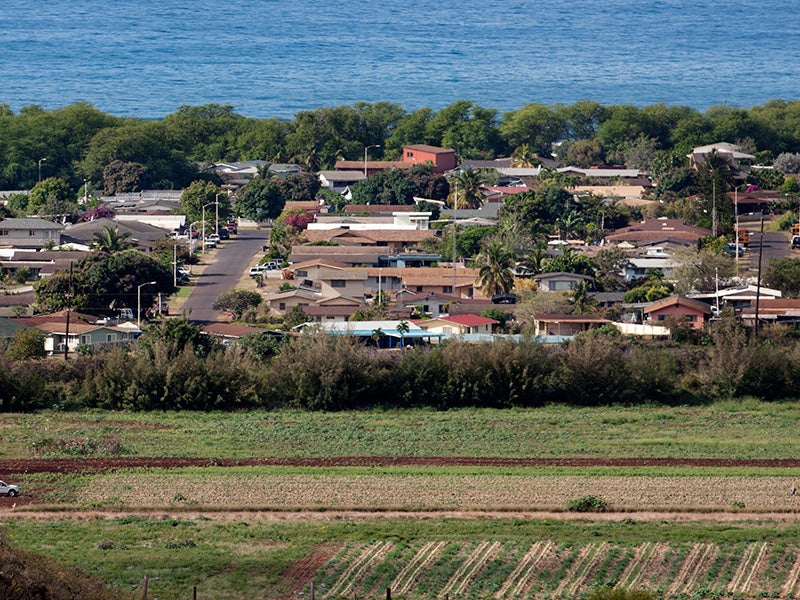Native Hawaiians Bring Civil Rights Complaint Against State Agencies on Pesticide Use
HDOA and ADC discriminate against Native Hawaiians harmed by pesticide drift
Contact
Today, community groups The Moms On a Mission (MOM) Hui and Pōʻai Wai Ola/West Kauaʻi Watershed Alliance, represented by Earthjustice, filed a complaint with the U.S. Environmental Protection Agency and U.S. Department of Agriculture, calling on both agencies to investigate the Hawaiʻi Department of Agriculture’s (HDOA’s) and Agribusiness Development Corporation’s (ADC’s) actions against Native Hawaiians in violation of Title VI of the Civil Rights Act of 1964. Title VI and agency regulations prohibit recipients of federal funding from engaging in practices that have the effect of discriminating on the basis of race, color, or national origin.
Photo by Earthjustice
ADC ditch draining seed crop lands before emptying into Majors Bay, Kauaʻi.
ADC facilitates the constant drift of pesticides and pesticide-laden dust into Native Hawaiian communities by leasing thousands of acres near them to heavy pesticide users, primarily genetically engineered seed companies, that spray tens of thousands of pounds of toxic pesticides each year. ADC makes no apparent effort to avoid these impacts, to protect these communities, nor even to consider the effect of its actions on them. In fact, ADC recently refused to continue complying with the Clean Water Act’s requirements to monitor, restrict, and report contaminants in its vast West Kauaʻi drainage canal system that weaves through the fields and empties millions of gallons of untreated waters into the ocean bordering Waimea and Kekaha.
Although HDOA has broad powers to limit communities’ pesticide exposure, such as by enacting regulations, restricting pesticide registration, and enforcing pesticide use laws, it has made remarkably little effort to do so. Instead, it routinely registers pesticides for local use without considering their impacts on Native Hawaiians, has lax enforcement, and fails to enact or support protections such as buffer zones and pesticide disclosure. These failures disproportionately harm Native Hawaiians in West Kauaʻi and on Molokaʻi, where large populations of Native Hawaiians live very close to large-scale spraying operations.
“I live in a community that is home to the largest population of pure blooded Native Hawaiian, native speakers in Hawaiʻi, what many would consider an endangered race and a wealth of cultural knowledge. We also happen to be a community that is inundated daily by exposure to industrial use pesticides. When you consider the danger of frequent, long-term exposure to industrial pesticides, some may consider this to be a form of genocide,” said Malia Chun, member of The MOM Hui and Kekaha resident.
“Allowing large-scale pesticide use without adequate protective measures is in direct opposition to our basic Hawaiian values of Aloha ʻĀina and our tradition of caring for Hawaiʻi’s natural resources and building healthy, sustainable communities,” said Pō‘ai Wai Ola member and Makaweli Valley kalo farmer John A‘ana.
The majority of the state’s pesticide-intensive seed production occurs in West Kauaʻi, where the proportion of Native Hawaiians significantly exceeds the statewide percentage. Seed companies on Molokaʻi spray fields in the center of the island between large tracts of Hawaiian Home Lands. On Molokaʻi, the proportion of Native Hawaiians is nearly triple the statewide percentage, and the proportion of pure Native Hawaiians is more than quadruple the statewide percentage. Although EPA regulations require recipients of federal funding to have a program to ensure their actions do not have discriminatory effects, neither ADC nor HDOA has one.
Agribusinesses heavily apply pesticides near schools, hospitals, and residential areas in these communities at distances far closer than agricultural operations in other parts of the country. Proximity to fields and maternal exposure to pesticides are associated with developmental problems in children, and higher rates of leukemia, asthma, and respiratory complications.
Earthjustice attorney Paul Achitoff noted, “If anyone began spraying toxic chemicals so that they drifted into homes and schools in one of Hawaiʻi’s affluent neighborhoods, there would be outrage and it would be shut down. But not on Kauaʻi’s west side or on Molokaʻi, because the Native Hawaiians there don’t have the political clout. It’s shameful and it’s against the law.”
What You Need To Know About Title VI of the Civil Rights Act of 1964
Because HDOA and ADC receive federal funding, the agencies have affirmative duties under Title VI of the Civil Rights Act of 1964 to ensure their programs and activities do not discriminate against communities of color, including Native Hawaiians. In its complaint, the community groups requested that EPA and USDA investigate HDOA and ADC and require both agencies to develop and implement Title VI compliance plans.
Maps:
Hawaiian population (race alone and in combination) and home lands, seed production, and schools on Kauaʻi and Molokaʻi.
Esri, HERE, DeLorme, NGA, USGS, NPS – Sylvana Cares, Ryan Perroy and Jeff Melrose – Please acknowledge the Spatial Data Analysis and Visualization Lab at the University of Hawaii at Hilo as a source when this data is used in the preparation of reports, papers, publications, maps, and other products.

Additional Resources
About Earthjustice
Earthjustice is the premier nonprofit environmental law organization. We wield the power of law and the strength of partnership to protect people's health, to preserve magnificent places and wildlife, to advance clean energy, and to combat climate change. We are here because the earth needs a good lawyer.